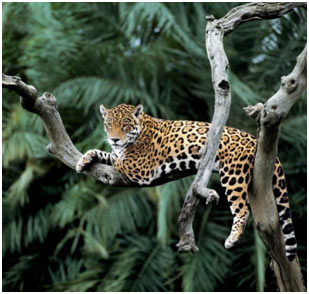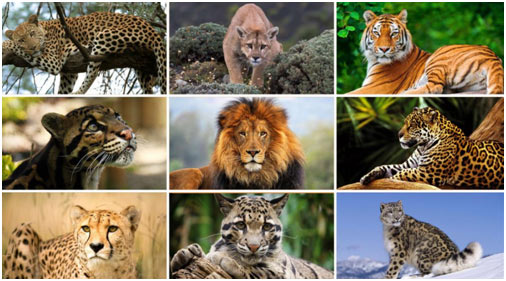World of Big Cats
The word “big cat” is usually utilized to refer to any of the five living members of the genus Panthera, specifically tiger, lion, jaguar, leopard, and snow leopard. Except for the snow leopard, these types have the ability to roar. A more liberal and expansive definition of the term consists of types beyond Panthera consisting of the cougar, leopard, Sunda clouded leopard, cheetah, and often a number of lynx species, although these added species likewise do not roar.
In spite of massive differences in size, numerous feline types are rather comparable in both structure and behavior, with the exception of the cheetah, which substantially stands out from the other huge and little felines. All cats are predators and some are effective apex predators. Their native ranges include the Americas, Africa, and Asia.
These big cats are among the most precious and recognizable animals on the planet. Here are some facts about these extraordinary thrilling big cats.
1.Lion
Scientific Name: Panthera leo
Lion “The King of the jungle” is a species of the genus Panthera. Lions mainly stick to the meadows, scrub, or open forests or woodlands and are native to eastern African countries like Kenya and Tanzania along with the Southern African nations like South Africa, Botswana, Zimbabwe, and Zambia and in Asia, they are found in Pakistan and India.
It has a muscular, deep-chested body, short, rounded head, round ears, and a hairy tuft at the end of its tail. Its fur differs in color from light buff to silvery grey, yellowish red, and dark brown. The white lion is rare with a genetic condition called leucism. The male lion’s mane is the most recognizable feature of the types; adult male lions have a prominent mane. Lions invest much of their time resting; they are inactive for about 20 hours per day.
The lion is a generalist hypercarnivore and is considered to be both a peak and keystone predator due to its extensive prey spectrum. Its prey consists primarily of mammals– particularly ungulates– plains zebra, African buffalo, gemsbok, and giraffe.
Among the most commonly identified animal signs in human culture, the lion has been thoroughly portrayed in sculptures and paintings, on nationwide flags, and in contemporary movies and literature.

2.Tiger
Scientific Name:Panthera tigris
The tiger is the biggest extant cat species and a member of the genus Panthera. It is most recognizable for its dark vertical stripes on orange-brown fur with a lighter underside. It is an apex predator, primarily preying ungulates such as deer and wild boar.
The distribution and habitat of tiger range from eastern Turkey, Indonesian islands of Sumatra, Java, and Bali to Pakistan and India. The tiger has a muscular body with effective forelimbs, a large head, and a tail that is about half the length of its body. There are three color versions– white, golden, and stripeless snow white.
When not subject to human disruption, the tiger is mainly diurnal. It is a strong swimmer and frequently bathes in ponds, lakes, and rivers, hence keeping cool in the heat of the day. Tigers and their superlative qualities have actually given fascination for humanity since ancient times, and they are routinely visible as important cultural and media concepts.

3.Cheetah
Scientific Name: Acinonyx jubatus
The cheetah is a large feline native to Africa and Iran. It is the fastest land animal, capable of running at 80 to 128 km/h (50 to 80 miles per hour), and has numerous adaptations for speed, including lightweight, long thin legs and a long tail. Cheetahs in eastern and southern Africa take place primarily in savannas like the Kalahari and Serengeti.
In main, northern, and western Africa cheetahs live in dry mountain ranges and valleys; its existence in Asia is limited to Iran, Afghanistan, Iraq, and Pakistan. The cheetah is characterized by a little rounded head, a short snout, black tear-like facial streaks, a deep chest, long thin legs, and a long tail. Its slender, canine-like form is highly adjusted for speed and contrasts greatly with the robust construct of the big cats.
Cheetahs are active mainly in the day time. The cheetah is a carnivore that hunts small to medium-sized prey which mainly is ungulates. The cheetah has been commonly depicted in a variety of creative works and typically included in marketing and animation.

4.Leopard
Scientific Name: Panthera pardus
The leopard is among the five extant species in the genus Panthera. The leopard’s fur is generally soft and thick. Its skin color varies between from pale yellow-colored to dark golden with dark spots grouped in rosettes (rose-like formations).
The leopard has the largest distribution of all wild cats, taking place extensively in Africa along with the Caucasus and Asia. The leopard is an antisocial and territorial animal. The leopard is a predator that prefers medium-sized prey. The most considerably preferred species are ungulates; impala, bushbuck, typical duiker, and chital.

5.Jaguar
Scientific Name: Panthera onca
The jaguar’s present habitat extends from the southwestern United States and Mexico in The United States and Canada, throughout much of Central America, and south to Paraguay and northern Argentina in South America. The jaguar is a compact and well-muscled animal and third-biggest feline in the world.
Its coat is typically a tawny yellow, however, ranges to reddish-brown, for most of the body. The adult jaguar is a peak predator, meaning it is at the top of the food chain and is not preyed upon in the wild. Like all felines, the jaguar is an obligate predator, feeding just on meat. The prey includes capybara, giant anteater, swine, and other mammals.
The jaguar and its name are widely used as a symbol in modern culture. There is an automotive company name Jaguar.

6.Puma
Scientific Name: Puma concolor
Its variety covers from the Canadian Yukon to the southern Andes in South America and is the largest of any big wild terrestrial mammal in the Western Hemisphere.
The head of the feline is round and the ears are erect. The coat is typically tawny like that of the lion, which is why it was initially called the “mountain lion”, however it otherwise ranges from silvery-grey or reddish with lighter patches on the underbody, consisting of the jaws, chin, and throat.
Infants are spotted and born with blue eyes and rings on their tails. An effective generalist predator, the cougar can consume any animal it can capture, from insects to large ungulates.

7.Lynx
Scientific Name: Felis lynx
Lynx has a short tail, special tufts of black hair on the ends of their ears, big, padded paws for strolling on snow, and long hairs on the face. Under their neck, they have a ruff that has black bars resembling a bow tie, although this is frequently not visible. Body-color differs from medium brown to goldish to beige-white and is occasionally marked with dark brown spots, particularly on the limbs. The lynx is generally an antisocial animal.
It feeds on a vast range of animals from white-tailed deer, reindeer, roe deer, small red deer, and chamois, to smaller, more normal prey: snowshoe hares, fish, foxes, sheep, squirrels, mice, turkeys, and other birds, and goats. It also eats ptarmigans, voles, and grouse.


